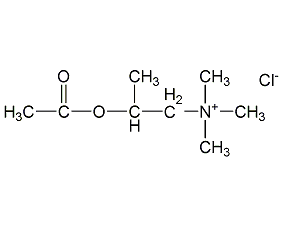
Structural formula
| Business number | 01CD |
|---|---|
| Molecular formula | C8H18ClNO2 |
| Molecular weight | 195.69 |
| label |
methacholine, Acetyl-beta-methylcholine chloride, Amechol, O-Acetyl-β-methylcholine, (2-Acetoxypropyl)trimethylammonium chloride, Methacholine chloride, (2-Hydroxypropyl)trimethylammonium chloride |
Numbering system
CAS number:62-51-1
MDL number:MFCD00011817
EINECS number:200-537-2
RTECS number:BR5250000
BRN number:4162373
PubChem number:24277821
Physical property data
1. Properties: White needle-like crystals, easy to deliquesce. Slightly fishy smell.
2. Density (g/mL, 25/4℃): Undetermined
3. Relative vapor density (g/mL, air=1): Undetermined
4. Melting point (ºC): 172–173
5. Boiling point (ºC, normal pressure): Undetermined
6. Boiling point (ºC, 5.2kPa) : Undetermined
7. Refractive index: Undetermined
8. Flash point (ºC): Undetermined
9. Specific rotation (º): Undetermined
10. Autoignition point or ignition temperature (ºC): Undetermined
11. Vapor pressure (kPa, 25ºC): Undetermined
12 . Saturated vapor pressure (kPa, 60ºC): Undetermined
13. Heat of combustion (KJ/mol): Undetermined
14. Critical temperature (ºC): Undetermined
p>
15. Critical pressure (KPa): Undetermined
16. Log value of oil-water (octanol/water) partition coefficient: Undetermined
17. Explosion upper limit (%, V/V): Undetermined
18. Lower explosion limit (%, V/V): Undetermined
19. Solubility: Easily soluble in water, ethanol, Chloroform, insoluble in ether. It decomposes when exposed to alkali and slowly decomposes when exposed to water.
Toxicological data
Acute toxicity: Rat oral LD50: 750 mg/kg; Rat subcutaneous injection LD50: 75 mg/kg; Rat intravenous LD50: 20 mg/kg; Mouse oral LD50: 740 mg/kg; Mouse intraperitoneal LD50 : 160 mg/kg; mouse subcutaneous injection LD50: 15 mg/kg; guinea pig intravenous LDLo: 3750 mg/kg;
Ecological data
None yet
Molecular structure data
None yet
Compute chemical data
1. Reference values for calculation of hydrophobic parameters���XlogP): None
2. Number of hydrogen bond donors: 0
3. Number of hydrogen bond acceptors: 3
4. Rotatable chemical bonds Number: 4
5. Number of tautomers: None
6. Topological molecule polar surface area 26.3
7. Number of heavy atoms: 12
8. Surface charge: 0
9. Complexity: 138
10. Number of isotope atoms: 0
11. Determine the atoms Number of stereocenters: 0
12. Uncertain number of stereocenters of atoms: 1
13. Determined number of stereocenters of chemical bonds: 0
14. Uncertain number of stereocenters of chemical bonds: 0
15. Number of covalent bond units: 2
Properties and stability
1. It is harmful if taken orally. When using, avoid inhaling the dust of this product and avoid contact with eyes and skin.
Storage method
1. Sealed or tightly sealed and stored dry at 40ºC. The solution should not be kept in refrigerated storage for more than two weeks.
Synthesis method
None yet
Purpose
1. Biochemical research.
2. It can stimulate M choline receptors, has strong selectivity for the cardiovascular system, and has a weak effect on gastrointestinal and bladder smooth muscles. It can also contract bronchial smooth muscles and increase bronchial secretion. It is stable and can be taken orally, but its absorption is small and irregular. It is inactivated slowly by cholinesterase in the body, so its effect is longer-lasting. It is mainly used for atrial tachycardia, but it is not the first choice and can be used again when other treatments are ineffective. It can also be used for peripheral vasospasm diseases, such as Raynaud’s disease and thromboangiitis obliterans. Oral administration, 200 to 500 mg each time, 2 to 3 times a day; subcutaneous injection, 10 to 25 mg each time.
Note:
(1) Symptoms of M choline receptor activation may occur in overdose (see bethanecholine).
(2) It is prohibited to be used for atrioventricular nodal and ventricular tachycardia, because it is not only ineffective, but can also cause atrial fibrillation.
(3) It is prohibited to be used in patients with bronchial asthma and hyperthyroidism.
(4) Intravenous injection is strictly prohibited.

 微信扫一扫打赏
微信扫一扫打赏

